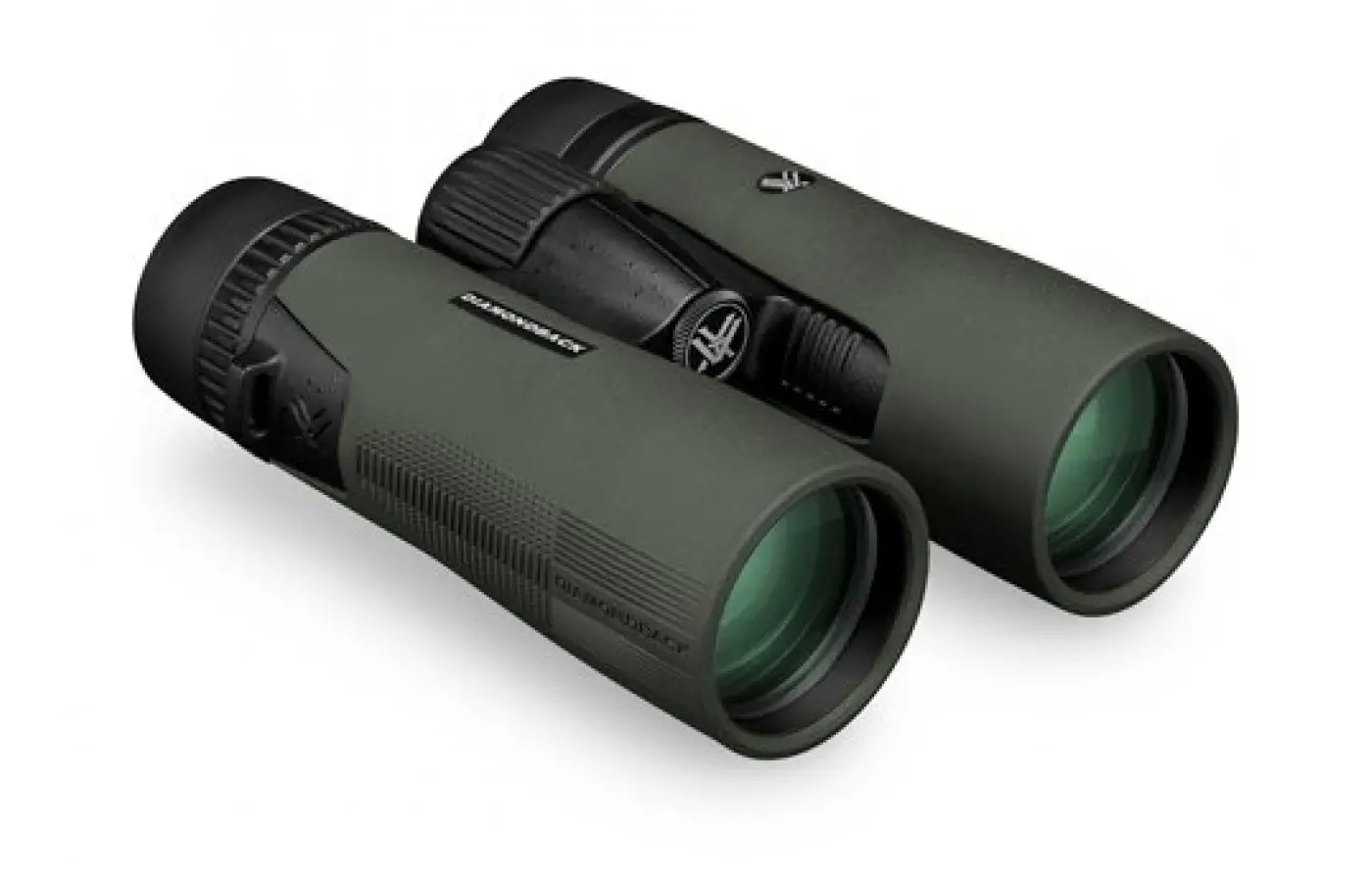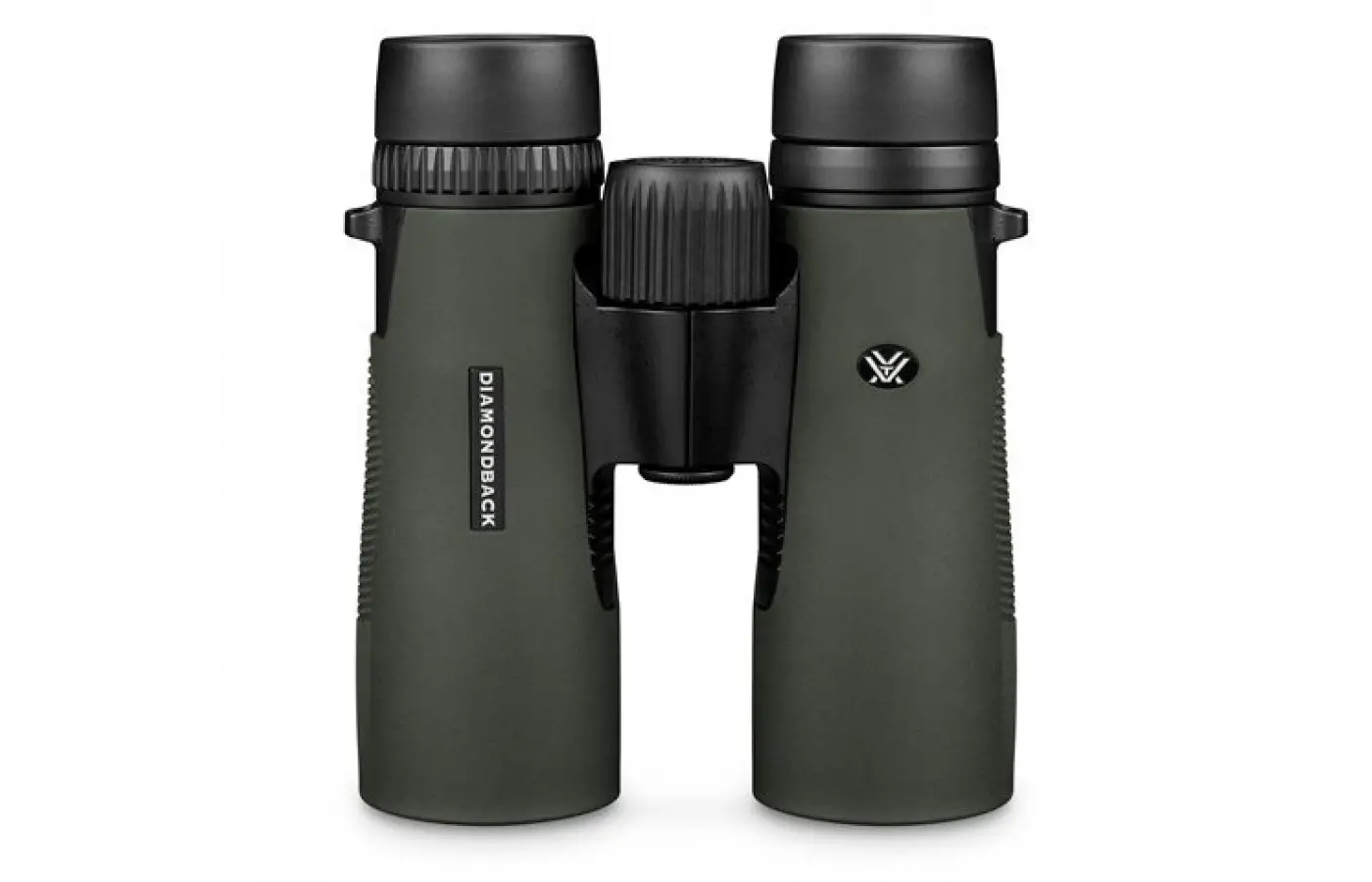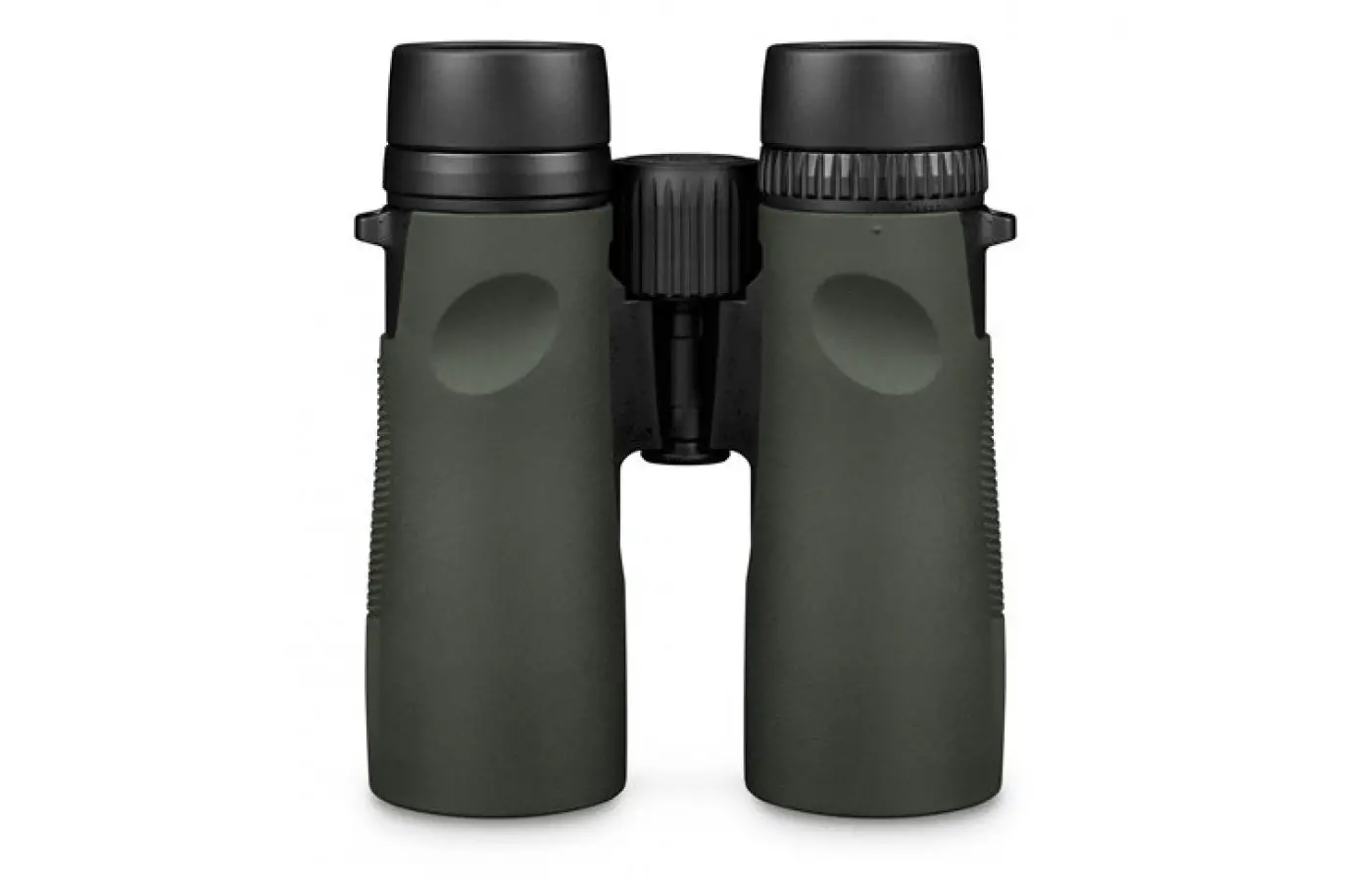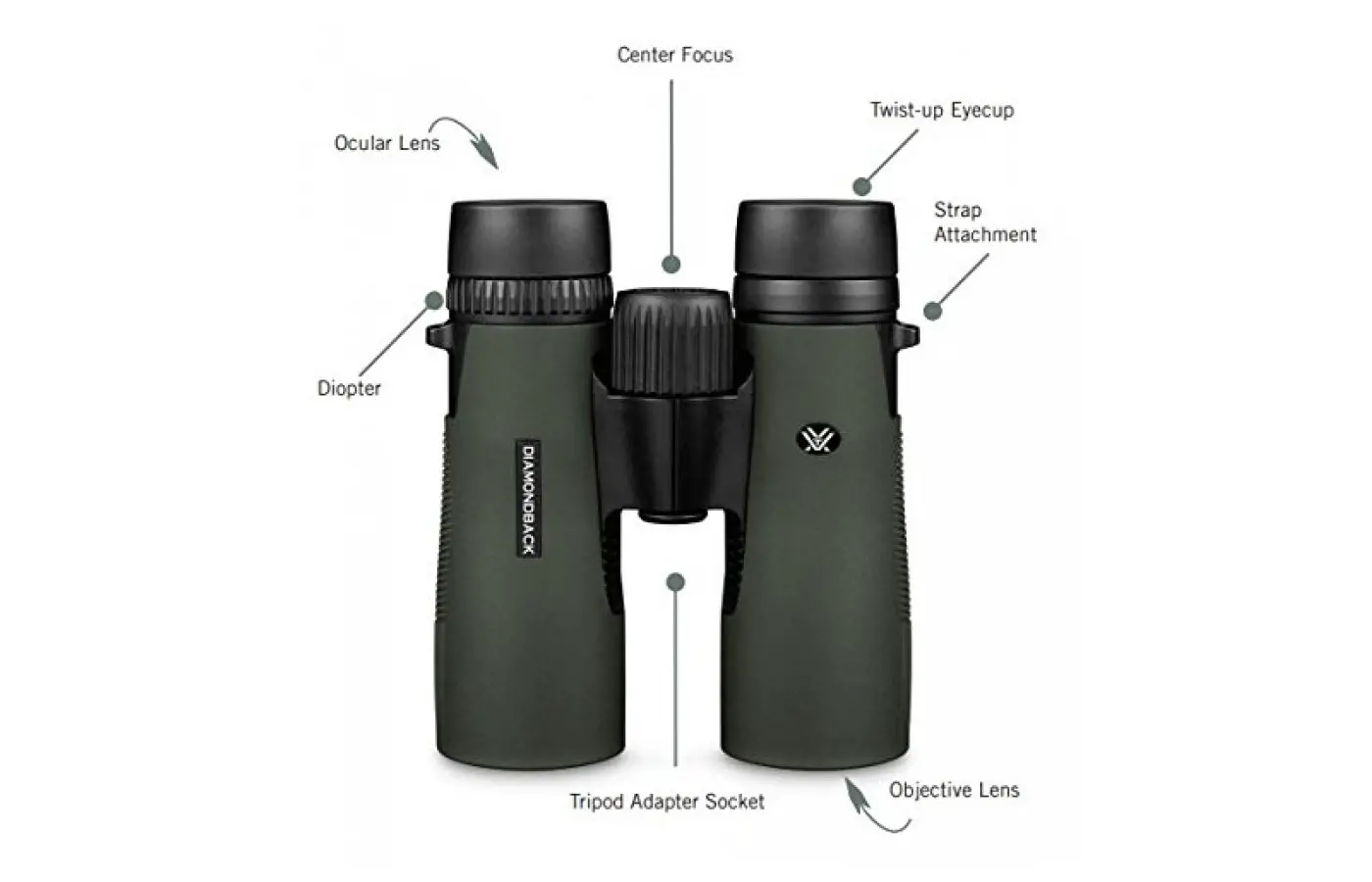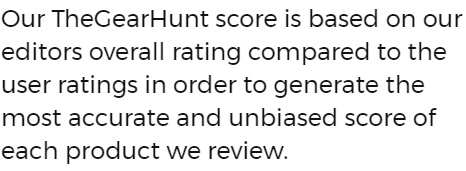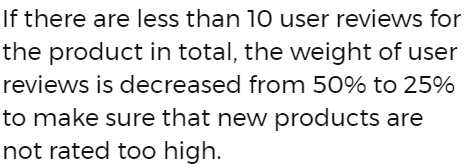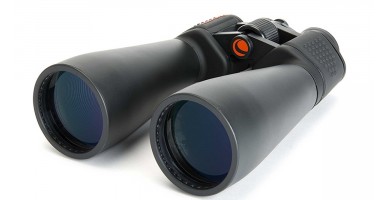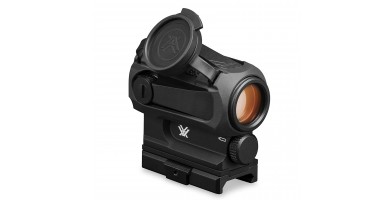Vortex Diamondback
Vortex Diamondback Review Facts
Vortex Optics is a popular brand of binoculars that offers a high-quality product and the accessories needed to maximize the viewing experience. The combined 8X magnification and 42mm objective provide a generous 60-degree angle of view for complete images of targets.
Improved true color, contrast, and transmission are optic features that are accomplished with phase-corrected roof prisms and multi-coated lenses. Experts have rated many of the highlights of the Vortex Diamondback binoculars on a scale of one to ten. The field of view received the highest rating. Brightness and ease of adjustments earned low scores.
Editor's Pros & Cons
Pros
- Fully, multi-coated optics
- Phase-corrected roof prism
- Water and fog proof with argon and o-rings
- Clarity
- Focus brightness
- Great field of view and close focus range
- Solid ergonomic casing
- Good color rendering
- Clean options inside tubes
- Quality prism made of BaK-4 glass
- Lifetime warranty
Cons
- Slightly heavier than most 8X42 binoculars
- Stiff middle hinge
- High chromatic aberration on the field of view edge
Type
The Vortex Diamondback binoculars are roof prism binoculars. Roof prism binoculars are streamlined. The eyepieces are in line with the objective lenses at the front. The roof prism is not bulky and is easier to hold than its counterpart, the Porro prism.
It is more costly to make and tends to be more expensive than the Porro prism. BaK--4 is one of the three prisms found in most binoculars. The BaK-4, used in the Vortex Diamondback is considered to be of the highest quality.
It is more costly to make and tends to be more expensive than the Porro prism. BaK--4 is one of the three prisms found in most binoculars. The BaK-4, used in the Vortex Diamondback is considered to be of the highest quality.
Magnification and Objective Lens Diameter
Near the objective lens, the interior of the barrels is nicely blackened, with ribbed and matted tubes near the lens. The situation deteriorates further on. Except for the edges, the objective lenses are too shiny. The area next to the prisms is matted and darkened. Further on, they are uncovered. Further on, they are uncovered. The interior of the barrel is very clean. Testers rated the interior barrel quality as six out of ten.
Numbers such as 8X42 refer to the magnification and diameter of the objective lens. The first number refers to the magnification. 8X means an object appears eight times closer than without the binoculars. The 42 is the diameter of the objective lens in millimeters.
Vortex Diamondback binoculars are available in eight models. The most common are the 8X42, 10X42, and 10X50. A larger objective lens permits more light. The image is usually clearer, depending on what is being viewed. Binoculars with bigger objective lenses are also bulkier, heavier, and harder to keep stable without a tripod or monopod.
Numbers such as 8X42 refer to the magnification and diameter of the objective lens. The first number refers to the magnification. 8X means an object appears eight times closer than without the binoculars. The 42 is the diameter of the objective lens in millimeters.
Vortex Diamondback binoculars are available in eight models. The most common are the 8X42, 10X42, and 10X50. A larger objective lens permits more light. The image is usually clearer, depending on what is being viewed. Binoculars with bigger objective lenses are also bulkier, heavier, and harder to keep stable without a tripod or monopod.
Exit Pupil
The amount of light reaching the eyed via the objective lens to the eyepiece is referred to as the exit pupil. Ideally, the diameter will be larger than a person's pupil, or the field of vision is reduced. The diameter of the human pupil is approximately 1.5mm when the light is very bright and nearly eight-mm under pitch-dark conditions. The exit pupil of binoculars is calculated by dividing the diameter of the objective lens by the magnification. Vortex Diamondback binoculars have an exit pupil of 4.2mm.
Lens Coating
Lens serves four purposes. It improves contrast, increases light transmission, makes color seem more vivid and reduces glare. Lenses can be uncoated, multi-coated, or fully coated. The Diamondback is a high-performing and amazingly efficient set of binoculars, enhanced with dielectric full, multi-coated lenses.
It shows beautiful pictures and performs impressively in low light, which is critical when glassing birds and game. Greenish antireflection coatings are everywhere. One air-to-glass surface is oddly shiny and has no coloring. Coatings were rated as eight out of ten by testers.
It shows beautiful pictures and performs impressively in low light, which is critical when glassing birds and game. Greenish antireflection coatings are everywhere. One air-to-glass surface is oddly shiny and has no coloring. Coatings were rated as eight out of ten by testers.
Angle of View and Field of View
An advantage the Vortex Diamondback has over similarly priced binoculars is a wider field of view and shorter close focus. Those are characteristics that make a difference when scouting distant landscapes or insect watching.
Most people don't notice the limitations in day to day use in close focus range. The Diamondback 8X42 boasts of a 420-foot field of view from a distance of 1000 yards. The field of view is greater than the majority of the competition. With its best-in-class field of view, covering ground and pinpointing targets is done with ease.
Most people don't notice the limitations in day to day use in close focus range. The Diamondback 8X42 boasts of a 420-foot field of view from a distance of 1000 yards. The field of view is greater than the majority of the competition. With its best-in-class field of view, covering ground and pinpointing targets is done with ease.
Price
It lists for $270 and packs optical quality in an affordable package. The $200+ is in the competitive price range. Some people spend over $2300. The Vortex Diamondback offers adequate brightness and excellent clarity for a pair of binoculars that costs less than $300.
Competitors that are similarly priced have more brightness with equal clarity. If found on sale, the Diamondback binoculars are a great buy. The binoculars can be purchased for $189 on Amazon. That price is more than a 20 percent discount.
Competitors that are similarly priced have more brightness with equal clarity. If found on sale, the Diamondback binoculars are a great buy. The binoculars can be purchased for $189 on Amazon. That price is more than a 20 percent discount.
Water Proof and Fog Proof
Unless a view has some experience watching something in nature while it rains, fully appreciating the importance of binoculars being sturdily waterproofed is not possible. Without waterproofing, viewers miss the opportunity to revel in some visual treats.
The Vortex Diamondback is 100 percent waterproof and fogproof. The binoculars can be used with it is hot and humid or misting. To be fogproof, the oxygen barrier of the binoculars are purged of oxygen that is replaced with argon gas. Argon gas doesn't fog up like oxygen when temperatures drop abruptly. Water vapor doesn't fall below its condensation point in the binoculars.
The Vortex Diamondback is 100 percent waterproof and fogproof. The binoculars can be used with it is hot and humid or misting. To be fogproof, the oxygen barrier of the binoculars are purged of oxygen that is replaced with argon gas. Argon gas doesn't fog up like oxygen when temperatures drop abruptly. Water vapor doesn't fall below its condensation point in the binoculars.
Durability
Rubber is a sought-after material for binoculars. It is easy to grip in any weather conditions. Rubber is placed on binoculars for the same reason it is used on fancy pens, pliers, and bicycle handles. Even with binoculars as sturdy as Vortex products, the viewer doesn't want to drop the binoculars.
The binoculars are rubber armor padded, are purged with argon, waterproofed and have a producer lifetime warranty. The rubber armor is not loose and does not stick out. There is no shoddy workmanship.
The roof prism design is both well-balanced and lightweight for the various configurations. The average person can handle the binoculars for extended use without becoming excessively tired. Due to the length of the hinge construction, the binoculars can stand up to the bumps and drops of regular use without twisting.
The binoculars are rubber armor padded, are purged with argon, waterproofed and have a producer lifetime warranty. The rubber armor is not loose and does not stick out. There is no shoddy workmanship.
The roof prism design is both well-balanced and lightweight for the various configurations. The average person can handle the binoculars for extended use without becoming excessively tired. Due to the length of the hinge construction, the binoculars can stand up to the bumps and drops of regular use without twisting.
Focus
The 4.5-feet close focus range is top notch. Most people can focus on a butterfly that lands on one of their shoes. It is a closer range than nearly all of its competition. Each barrel of the Vortex Diamondback can be individually focused.
Use the central wheel, adjust the right eye for compensating the difference between eyes. When the adjustment is made to the right eye, it is unlikely it will have to be touched again. Focusing is then adjusted using the central focusing knob. Viewers having better vision in one eye can adjust the binoculars for both eyes easily.
A comfortable, big central wheel has ribs that move smoothly and is well-damped. To run The 4.5-feet close focus range is top notch. Most people can focus on a butterfly that lands on one of their shoes. It is a closer range than nearly all of its competition. Each barrel of the Vortex Diamondback can be individually focused.
Use the central wheel, adjust the right eye for compensating the difference between eyes. When the adjustment is made to the right eye, it is unlikely it will have to be touched again. Focusing is then adjusted using the central focusing knob. Viewers having better vision in one eye can adjust the binoculars for both eyes easily.
A comfortable, big central wheel has ribs that move smoothly and is well-damped. To run through the entire distance scale requires a turn through a possible 640 angle. The outer lens dioptre adjustment is moved through a ring located on the right eyepiece.
The close focus has been improved to five feet, providing a sharp focus and plenty of focus range for close-ups of wildlife, monument details, or nearby street signs as well as faraway scenery.
Use the central wheel, adjust the right eye for compensating the difference between eyes. When the adjustment is made to the right eye, it is unlikely it will have to be touched again. Focusing is then adjusted using the central focusing knob. Viewers having better vision in one eye can adjust the binoculars for both eyes easily.
A comfortable, big central wheel has ribs that move smoothly and is well-damped. To run The 4.5-feet close focus range is top notch. Most people can focus on a butterfly that lands on one of their shoes. It is a closer range than nearly all of its competition. Each barrel of the Vortex Diamondback can be individually focused.
Use the central wheel, adjust the right eye for compensating the difference between eyes. When the adjustment is made to the right eye, it is unlikely it will have to be touched again. Focusing is then adjusted using the central focusing knob. Viewers having better vision in one eye can adjust the binoculars for both eyes easily.
A comfortable, big central wheel has ribs that move smoothly and is well-damped. To run through the entire distance scale requires a turn through a possible 640 angle. The outer lens dioptre adjustment is moved through a ring located on the right eyepiece.
The close focus has been improved to five feet, providing a sharp focus and plenty of focus range for close-ups of wildlife, monument details, or nearby street signs as well as faraway scenery.
Tripod Mount
Amateurs wonder if they can use a tripod with binoculars. A special adapter is needed to use a tripod with the Vortex Diamondback. A tripod removes the risk of an unsteady image seen when holding the binocular to the eyes. People move a bit regardless of how still they try to be. Looking through a binocular score makes the fact obvious. Access for a tripod is quite sensible.
Clarity
The Vortex Diamondback is clear. It feels as though the viewer is looking at images of high-definition. There is slight blurring near the edges which makes images less exciting and vibrant than top-tier models.
It is crystal clear where it matters. Testing had no trouble picking out minute markings of model birds. The binoculars earned a score of eight out of ten for clarity. Compared to other binoculars in the same price range, the clarity is of equal quality. They have significantly less blurring on the edges than most.
It is crystal clear where it matters. Testing had no trouble picking out minute markings of model birds. The binoculars earned a score of eight out of ten for clarity. Compared to other binoculars in the same price range, the clarity is of equal quality. They have significantly less blurring on the edges than most.
Brightness
The Diamondback is bright enough for 95 percent of situations. Viewers may not be pleased very early in the morning or late in the afternoon on an overcast day. On such days, images may look more like silhouettes and lose some detail. Brightness was rated at seven out of ten. It is a significant area in which the Diamondback falls short of the competition.
Ease of Adjustment
Small difficulties in adjustment is the reason behind a seven out of ten rating. The smooth action of the focus knob allows easy and precise adjustment. The eyecup twists out. Most preferences are accommodated by three stops.
When being adjusted, the dioptre knob moves fairly easily but is stiff enough to be difficult and can be accidentally thrown out of whack. The main hinge is a bit hard to adjust. The main hinge dictates the distance between the eyepieces. Being a bit stiff is an asset for binoculars that get lots of use. It is annoying when passing the binoculars around.
When being adjusted, the dioptre knob moves fairly easily but is stiff enough to be difficult and can be accidentally thrown out of whack. The main hinge is a bit hard to adjust. The main hinge dictates the distance between the eyepieces. Being a bit stiff is an asset for binoculars that get lots of use. It is annoying when passing the binoculars around.
Construction Quality
Vortex has a reputation for making quality binoculars at prices that are relatively low. The Diamondback is another example of their quality products. Everything from the ED glass smooth moving parts to the rugged rubber feels high-quality.
Higher quality materials should cost hundreds of dollars more than the price of a Vortex Diamondback. Construction quality was rated at eight out of ten. It is even in quality with its main competition and noticeably better than some.
Higher quality materials should cost hundreds of dollars more than the price of a Vortex Diamondback. Construction quality was rated at eight out of ten. It is even in quality with its main competition and noticeably better than some.
Comfort
Vortex has a reputation for making quality binoculars at prices that are relatively low. The Diamondback is another example of their quality products. Everything from the ED glass smooth moving parts to the rugged rubber feels high-quality.
Higher quality materials should cost hundreds of dollars in excess of the price of a Vortex Diamondback. Construction quality was rated at eight out of ten. It is even in quality with its main competition and noticeably better than some. The neck strap is cushioned and wide where it rests on your neck. Carrying the binoculars is easier and more comfortable than using a thin strap or a cushion on the strap that slides.
Higher quality materials should cost hundreds of dollars in excess of the price of a Vortex Diamondback. Construction quality was rated at eight out of ten. It is even in quality with its main competition and noticeably better than some. The neck strap is cushioned and wide where it rests on your neck. Carrying the binoculars is easier and more comfortable than using a thin strap or a cushion on the strap that slides.
Key Features
8X magnification and 42 mm objective lens that provide bright images under most lighting conditions
393-foot field of view from 1000 yards
Eye relief of 17mm
Exit pupil of 5.3mm
Fully, multi-coated prism that improves brightness, clarity, and transmission
Phase-corrected prisms that will enhance transmission, contrast, and accurate color
Roof prism design
Wide 60-degree apparent angle of view
Short-hinge exposes more surface and cuts weight for handling
Adjustable interpupillary distance from 55mm to 75mm
Focusing wheel has oversized knurled center
Right eyepiece with textured dioptre ring
Soft tapered rubber caps
Durable and lightweight aluminum body
Exterior slip-resistant rubber armor
Fog and waterproof
O-ring sealed and argon-purged
393-foot field of view from 1000 yards
Eye relief of 17mm
Exit pupil of 5.3mm
Fully, multi-coated prism that improves brightness, clarity, and transmission
Phase-corrected prisms that will enhance transmission, contrast, and accurate color
Roof prism design
Wide 60-degree apparent angle of view
Short-hinge exposes more surface and cuts weight for handling
Adjustable interpupillary distance from 55mm to 75mm
Focusing wheel has oversized knurled center
Right eyepiece with textured dioptre ring
Soft tapered rubber caps
Durable and lightweight aluminum body
Exterior slip-resistant rubber armor
Fog and waterproof
O-ring sealed and argon-purged
Bottom Line
The Vortex Diamondback binoculars are a great pair of binoculars. Other models in the same price range have a brightness that is slightly better. The binoculars performed well in testing, moving up the leaderboard. It was not able to beat out other models in price.
Binoculars having better low light performance have a slight edge on the Diamondback. It is aesthetically and functionally pleasing. The binoculars have a sleek look and a thoughtful short-hinge design. There is plenty of room for the hands which makes holding them easy.
The build quality and appearance of the Diamondback are significant points in its favor. It can attract attention which is a serious asset. The casing is nearly flawless, inner tubes are cleaner than more expensive binoculars and provide pupils that are almost round. If the internal part of the tubes were blackened better, it would improve the overall quality.
Binoculars having better low light performance have a slight edge on the Diamondback. It is aesthetically and functionally pleasing. The binoculars have a sleek look and a thoughtful short-hinge design. There is plenty of room for the hands which makes holding them easy.
The build quality and appearance of the Diamondback are significant points in its favor. It can attract attention which is a serious asset. The casing is nearly flawless, inner tubes are cleaner than more expensive binoculars and provide pupils that are almost round. If the internal part of the tubes were blackened better, it would improve the overall quality.





